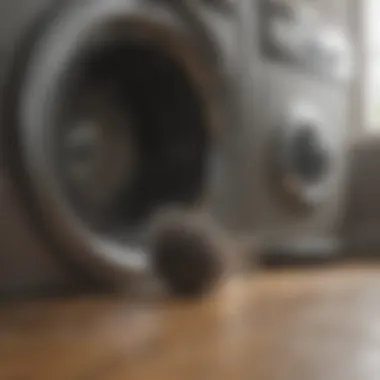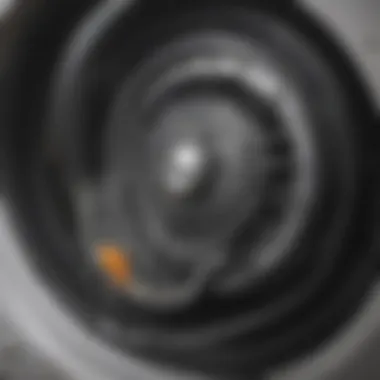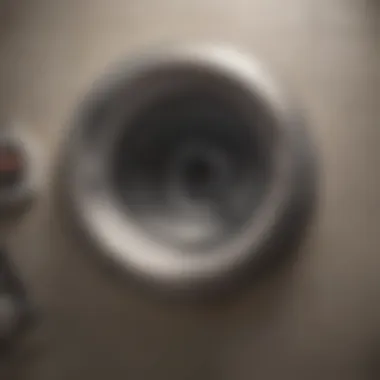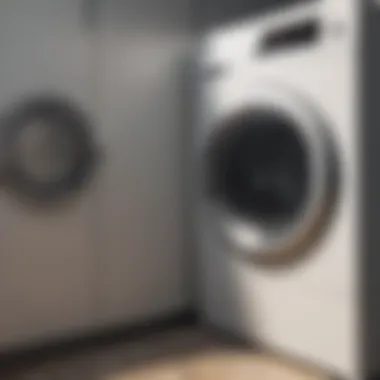Choosing the Right Dryer Vent Cleaning Tools


Overview of Topic
When it comes to home improvement, one area that's often overlooked is the cleaning of dryer vents. Many homeowners might not realize that a clogged dryer vent can lead to serious problems, not just in terms of efficiency but also in safety. The purpose of this article is to delve into the vital role that proper dryer vent maintenance plays for households. After all, ensuring that your dryer is operating at peak performance can save time and energy, which is especially important for busy families.
Importance of the Topic
A clean dryer vent is not just about keeping your appliances working smoothly; it directly affects the lifespan of your dryer, your home’s energy consumption, and even the safety of your home. Lint and debris buildup can cause your dryer to overheat, leading to fire hazards. According to the National Fire Protection Association, failure to clean dryer vents is a leading cause of home clothes dryer fires. By investing time in understanding and utilizing the right tools for vent cleaning, homeowners can foster a safer and more efficient laundry experience.
Common Challenges and Solutions
Cleaning dryer vents doesn’t often make it to the top of a homeowner's to-do list, and that can present several challenges. Let's explore some common issues:
- Clogs and Blockages: Lint buildup can create blockages, leading to reduced airflow.
- Difficulty Accessing the Vent: Many homeowners find it hard to reach their dryer vents, especially if they��’re in tight or awkward spaces.
- Unawareness of Cleaning Frequency: Some might not have a clear idea of how often dryer vents should be cleaned.
Solutions and Tips
To tackle these challenges, consider these helpful tips:
- Regular Inspections: Take a peek at your dryer vent at least once a month to look for signs of lint buildup.
- Use the Right Tools: Invest in quality dryer vent cleaning tools, like flexible brushes or vacuums specifically designed for this purpose.
- Establish a Cleaning Schedule: Aim to clean your dryer vent at least twice a year to prevent major clogs.
Product Recommendations
Investing in the right equipment is crucial for effective dryer vent cleaning. Here’s a breakdown of some of the best products available in the market:
- Everbilt Dryer Vent Cleaning Kit: This kit includes multiple brushes and rods to reach different lengths of the vent. Great for homeowners looking to do a thorough job.
- Holikme Dryer Vent Cleaner Kit: With a flexible rod design, this kit can navigate through curved vents easily. It's particularly helpful for those with tricky vent setups.
"A clean dryer vent is critical not just for dryer performance but also for household safety."
These products offer ease of use and efficiency, making it simpler to tackle a task that can otherwise become frustrating.
Step-by-Step Guides
To make the process of cleaning your dryer vent straightforward, following a clear step-by-step process is key:
- Gather Tools: Get your dryer vent cleaning kit, a vacuum, and a screwdriver if needed.
- Disconnect Your Dryer: Always unplug your dryer from the electrical outlet for safety. If it’s a gas dryer, turn off the gas supply.
- Access the Vent: If your dryer vent has a cover, remove it using a screwdriver. This will expose any lint buildup.
- Use the Cleaning Brush: Insert the cleaning brush into the vent and rotate while pulling it out. This helps dislodge lint buildup.
- Vacuum the Area: Use a vacuum to suck out any remaining debris. Ensure you cover every accessible section.
- Reassemble and Test: Once you're done, reattach any covers, plug in the dryer, and run it for a few minutes to ensure airflow is restored.
By following these steps, you’ll enjoy the benefits of a clean dryer vent, including quicker drying cycles and peace of mind knowing your home is safer.
Prologue to Dryer Vent Maintenance
Keeping a clean dryer vent is more than just a tidy house chore; it serves a vital role in ensuring your appliance functions efficiently and safely. Many homeowners underestimate the significance of regular dryer vent cleaning. A clean vent not only enhances dryer performance but also minimizes the risk of fire hazards — a major concern often overlooked until it’s too late.
Regular maintenance of dryer vents entails checking for clogs and obstructions that can accumulate lint and debris over time. Lint buildup can act as a roadblock to airflow, leading to overheating and, in extreme cases, fires. Therefore, understanding how often and why to maintain your dryer vent is paramount for both safety and efficiency.
Understanding the Importance of Dryer Vent Cleaning
When it comes to dryer safety, the importance of routine cleaning cannot be emphasized enough. A clean vent leads to better airflow, which means your dryer can operate effectively without running for multiple cycles. If your clothes take unusually long to dry, it might be high time to inspect your vent. Moreover, a properly maintained dryer can also help reduce energy bills. Less energy is consumed when the dryer works as intended.
According to the U.S. Fire Administration, improper maintenance is one of the leading causes of residential dryer fires. Taking the initiative to invest in cleaning can not only safeguard your home but also prolong the lifespan of the unit itself. Regular cleaning routines cultivate peace of mind, allowing you to focus on your daily tasks rather than the looming threat of potential hazards.


Common Risks Associated with Clogged Vents
Clogged dryer vents do more than slow down drying times; they pose several risks that every homeowner should be aware of. Here are a few key concerns:
- Fire Hazard: Lint is highly flammable. Clogged vents can trap heat, leading to ignition.
- Increased Energy Costs: The more your dryer runs, the higher your electric bill climbs. If airflow is restricted due to lint buildup, the appliance must work harder.
- Wear and Tear on Appliance: Overwork stress can lead to breakdowns. Frequent repairs are often linked to neglecting routine vent cleaning.
- Health Concerns: Mold and mildew can develop in damp, blocked vents, which may lead to airborne allergens and other health issues.
"Taking care of your dryer vent isn't just about appliance maintenance; it's about safeguarding your home and family."
Addressing these risks by ensuring ventilation is clear will provide peace of mind and make your home a safer space. Ultimately, regular dryer vent maintenance should be a prioritized part of home upkeep, much like changing air filters or checking smoke alarms.
Identifying the Best Tools for Cleaning Dryer Vents
Choosing the right tools for dryer vent cleaning is not just a matter of preference; it’s fundamental for ensuring the effectiveness and safety of the maintenance process. Various tools available on the market each come with their unique advantages and disadvantages. This section will explore the critical aspects to consider while identifying the best tools that align with your specific needs and expectations. A well-chosen tool can mean the difference between a quick cleaning session and a thorough, effective one.
Manual vs. Electrical Cleaning Tools
When deciding between manual and electrical cleaning tools, it is essential to weigh the pros and cons of each type. Manual tools, such as brushes or rods, often require more effort but can provide a hands-on approach that allows cleaner maneuverability within tight spaces. They offer flexibility; for example, a long brush, made from robust bristles, can effortlessly get into those corners where lint tends to accumulate. The simplicity of manual tools appeals to many, as they require no batteries or charging, just your personal effort.
However, electrical tools come equipped with power-driven features that can significantly cut down the time spent cleaning. These gadgets often boast attachments specifically designed for dryer vents and can actively remove deep-seated lint with minimal input from the user. Although they provide convenience, electric tools may come with a heftier price tag and require occasional maintenance of their own. Always consider your physical comfort and the size of your dryer vent when deliberating between the two.
"Whatever tool you select, remember that consistency is key! Regular maintenance prevents bigger issues down the line."
Overview of Popular Brands
In the realm of dryer vent cleaning, numerous brands are vying for attention, each aiming to provide the best products out there. Some well-regarded names include LintEater, Holikme, and Deflecto.
- LintEater is often the go-to for homeowners, thanks to its comprehensive kits that feature everything needed to tackle lint buildup effectively. LintEater’s flexible rods can be adjusted to match the specific needs of your setup, allowing deeper reaches into tight spaces.
- Holikme has also carved a niche for itself with its user-friendly brushes and attachments, providing a cost-effective solution without compromising on performance. Their products are generally built for easy assembly and disassembly, making cleanup a breeze.
- Deflecto, on the other hand, has made a name for itself in specialized vacuum attachments. Their systems often integrate seamlessly with standard vacuum cleaners, optimizing cleaning efficiency while simplifying the process.
As you sift through your options, look for user reviews and ratings. These can offer invaluable insights into durability, effectiveness, and ease of use. Whether you lean towards manual tools or modern electric gadgets, picking a reputable brand can enhance your cleaning routine and ensure that your dryer operates at peak performance.
Features to Consider in Dryer Vent Cleaning Tools
When it comes to cleaning your dryer vent, the right tool can make all the difference. It’s not just about getting something off the shelf; it’s about understanding what features your cleaning tool should have to ensure safe and efficient operation. By pinpointing specific elements, you can tailor your choice to meet both your immediate cleaning needs and the long-term upkeep of your appliance. Let's take a closer look at this topic to truly feel the impact of well-considered choices.
Material Quality and Durability
Choosing the right materials for your dryer vent cleaning tools is crucial, and it can directly influence their longevity. A sturdy brush made from high-quality nylon bristles can effectively remove lint buildup without damaging your venting system. Alternatively, metal tools might offer specific benefits but can also scratch or cause other forms of damage if not handled carefully. With durability in mind, look for tools that boast:
- Heavy-duty construction: Tools that can withstand repeated use are a worthwhile investment.
- Corrosion resistance: Since dryer vents can often be exposed to moisture, make sure materials can handle such conditions without deteriorating.
Consider this: investing in a more durable product now means you might avoid the hassle and expense of replacing it months down the road. A well-made tool stands the test of time.
Length and Flexibility of Cleaning Rods
Length and flexibility in cleaning rods can significantly enhance your reach and effectiveness when cleaning the often-tough corners of your dryer vent. The longer the rod, the deeper you can go, and a flexible rod can navigate the bends and turns of your venting setup more easily.
- When selecting rods, keep in mind the specific layout of your dryer vent. If it is short and straight, even rigid rods can suffice. On the other hand, complex setups require flexibility and perhaps some extensions that can help maneuver tight spots.
- One often overlooked point is the ease of interconnecting rods. Some rods screw together easily, while others might require some effort to attach and detach. This is important, especially if you’re looking to quickly clean your vent and not lose your patience in the process.
Compatibility with Different Dryer Models
Not every cleaning tool works for every dryer model, making compatibility an essential consideration. Always check if the tool you are interested in can fit your dryer’s venting system. This aspect becomes even trickier because vent setups can differ widely. You may encounter:


- Duct sizes: Standardized options exist, but always measure your existing ducts before buying. Many handy cleaning tools come with adaptable attachments.
- Specialized brands: Sometimes, specific dryer brands have unique requirements that make them incompatible with generic solutions. Pay attention to manufacturer recommendations, as they may offer insight into compatible cleaning tools.
By using tools that align perfectly with your dryer’s specifications, you not only avoid damage but also maximize cleaning effectiveness.
"Investing in the right cleaning tools pays off in terms of safety, efficiency, and longevity of your appliance."
Conducting a Comparison of Top Tools
When it comes to cleaning your dryer vent, understanding the tools available is pivotal. Comparing the different options helps in making a wise choice that aligns with personal needs and preferences. This section delves into an important aspect of the article: assessing tools for their effectiveness and suitability. Each tool comes with its own advantages and disadvantages, which can greatly influence not just cleanliness but also the safety and efficiency of your dryer.
Handheld Cleaners: Pros and Cons
Handheld cleaners are often touted for their convenience and ease of use. These compact devices offer several notable benefits:
- Portability: They can be easily transported around the house and stored without taking up much space.
- Simplicity: Their straightforward design makes them user-friendly, suitable even for those who may not have much experience with home maintenance.
However, there are some downsides:
- Limited Reach: Depending on the model, these tools may not reach far enough into longer vents, potentially leaving some areas uncleaned.
- Less Powerful: Compared to more sophisticated systems, handheld cleaners might lack the power needed for stubborn lint blockages.
"The right tool can make all the difference in achieving a truly thorough clean. Don't rush choosing one!"
Extendable Brush Kits: Features and Benefits
Extendable brush kits bring versatility to the table. They typically consist of several rods that can be connected to reach various lengths. Key features include:
- Adjustable Lengths: This adaptability allows the user to clean vents of different sizes, making it an all-in-one solution.
- Durability: Most kits are made from sturdy materials that can withstand the rigors of vent cleaning, ensuring they last through multiple uses.
Benefits of these kits are clear:
- Thorough Cleaning: The brushes can flex and navigate bends in the vent, which often traps lint and debris.
- Cost-effective: Since these kits tend to be affordable, they offer good value, especially if you're diligent with maintenance.
Vacuum Attachment Systems: Effectiveness Reviewed
Vacuum attachment systems are becoming increasingly popular due to their efficiency. They typically consist of various nozzles and hoses that connect to your vacuum cleaner. Here’s what to consider:
- Powerful Suction: These systems leverage the powerful suction from a traditional vacuum, allowing for effective lint removal, and even catching debris that would otherwise linger in the vent.
- Compatibility: Many setups can be adjusted to fit different vacuum models, providing great flexibility in use.
The effectiveness of vacuum attachments is notable for several reasons:
- Deep Cleaning: They can pull out debris from both the vent and the dryer itself, reducing fire risks significantly.
- Quick Cleanup: As these systems work rapidly, they can save time while ensuring thoroughness.
In summary, a thoughtful comparison of available cleaning tools will help navigate the sea of options, leading to an informed decision. Evaluating handheld cleaners, extendable brush kits, and vacuum attachment systems will ultimately empower homeowners to maintain safety and efficiency in their dryer vent systems.
Steps for Effective Dryer Vent Cleaning
Cleaning your dryer vent is more than a chore; it's a crucial upkeep task that helps keep your home safe and your dryer functioning efficiently. Regular maintenance of your dryer vent not only minimizes the risk of fire but also enhances energy efficiency and prolongs the life of your appliance. Homeowners and housewives alike should understand the importance of meticulously evaluating the steps involved in this process, ensuring you're well-prepared and know how to handle the task. Let's break down the essential steps for effective dryer vent cleaning, helping you navigate from the initial preparations to the rewarding outcomes of a thorough cleaning.
Preparation Before Beginning the Process
Before jumping into cleaning the vent, preparation is key. This stage lays the groundwork for a smoother experience, ensuring you have all the necessary tools and a plan in place. First off, gather your tools. You’ll want equipment such as a vacuum cleaner with a hose attachment, a set of dryer vent brushes, and perhaps a flashlight. You don’t want to be halfway through the cleaning and realize you’re missing something crucial.


Next, unplug your dryer. It’s critical to eliminate any potential hazards while working on this project. Move the dryer away from the wall to give you ample space to work, being mindful of the vent's connection to the wall. Also, it's wise to check the outside vent outlet. Ensure there’s no debris blocking it, as this can complicate your cleaning efforts. Don’t forget to dust off the area—using a microfiber cloth can help capture pesky fibers that may interfere with the process.
Techniques for Using Cleaning Tools
Once your setup is complete, it’s time to tackle the actual cleaning process. Start with the flexible dryer vent brush. Insert the brush into the duct and push it through cautiously. It's important to take your time and ensure it reaches all the nooks and crannies to dislodge lint build-up. A gentle twisting motion can help loosen any stubborn debris.
While you're at it, utilize your vacuum cleaner. The hose attachment is particularly useful for sucking up loose lint and dust—give it a good run through the vent. This two-pronged approach—brushing and vacuuming—creates a thorough clean, reducing the risk of future clogs. Be sure to inspect the brush after cleaning; if it’s too clogged, you might have to switch it out for a fresh one.
Post-Cleaning Inspection Procedures
Once you've cleaned the vent, don't simply close the book on the task. A post-cleaning inspection is a vital milestone to ensure everything is functioning properly. After reconnecting your dryer, run it for about 10 to 15 minutes on a low setting. Keep an eye out for unusual noises, and make sure air is flowing freely from the vent outside. This lets you catch potential issues early before they escalate.
Additionally, take a moment to examine the vent connection points for any signs of wear or damage. If you notice anything out of the ordinary, you might need to replace parts or even consult a professional. Regular inspections can greatly enhance efficiency, allowing your dryer to perform at its best while you remain worry-free about safety hazards.
Following these steps ensures your dryer vent remains in top-notch condition, ultimately safeguarding your home from any associated hazards. Not only does it promote safety, but it also enhances energy efficiency and the overall lifespan of your appliance.
Best Practices for Regular Maintenance
Regular maintenance of dryer vents is not just about keeping your appliance functioning well; it’s essential for safety and efficiency. A clean dryer vent reduces the risk of fires, which can be devastating and costly. Besides, a clear path allows your dryer to work more efficiently, saving on energy costs. Who wouldn’t want to stretch their dollar a little further while also ensuring their home is safe?
So what does good maintenance involve? Establishing a cleaning schedule along with recognizing the signs that indicate when cleaning is necessary can make a world of difference. Let’s delve into these two components.
Establishing a Cleaning Schedule
Creating a cleaning schedule is key to maintaining dryer vent performance. Think of it like a bedtime routine for your dryer—everyone needs some upkeep from time to time. Recommendations suggest that you should clean your dryer vent at least once a year. However, if you do a lot of laundry or notice your dryer gets pretty hot, you might want to bump that up to every six months. Here’s how to create an effective cleaning regime:
- Assess Usage: If you’re a busy household with mountains of laundry weekly, frequency should be a priority.
- Set Reminders: Use a calendar or an app to remind you when it’s time for a cleaning session. Mark that day as important as a family gathering.
- Create a Checklist: Outline steps to follow before you start cleaning. This can help keep things organized and ensure you don’t skip any crucial steps.
Taking these proactive steps means you’re one step ahead. You won’t have to scramble when a red flag pops up.
Signs Indicating Immediate Cleaning is Necessary
While a regular schedule is great, it's equally crucial to be vigilant for critical signs that signal an urgent need for cleaning. Ignoring these can lead to trouble, sooner or later. Here are a few telltale signs:
- Longer Drying Times: If clothes take longer than usual to dry, it may be a sign that lint is clogging the vent.
- Hot Dryer or Clothes: If you notice that your dryer is unusually hot, or your clothes come out warmer than they should, there’s a problem.
- Burning Smell: This is a serious red flag! If there’s a burning scent when your dryer is running, shut it off immediately—this could mean lint is catching fire.
- Excess Lint: If you notice a lot of lint buildup in and around the dryer vent and lint trap, it’s high time for a thorough cleaning.
Remember: Not addressing these signs can lead to potential fire hazards and higher utility bills.
Closure: Making an Informed Decision
In the realm of dryer vent maintenance, making a well-informed decision can significantly affect both the safety and efficiency of your appliance. After considering various cleaning tools available, it becomes clear that understanding your personal needs plays a central role in choosing the right equipment. Each home presents unique challenges, from the configuration of the vent to the frequency of use, so taking the time to evaluate your situation is crucial.
Evaluating Personal Needs and Preferences
When selecting a dryer vent cleaning tool, you should reflect on your lifestyle and specific requirements. For instance, if you're a busy household, you might prefer tools that offer quick cleanup or require less frequent maintenance. On the other hand, if you enjoy DIY projects, an extendable brush kit could satisfy your inclination to get hands-on with cleaning.
Consider the following:
- Vent Configuration: Some homes have long, convoluted venting systems that might benefit from flexible tools.
- Frequency of Vent Cleaning: If you’re someone who neglects maintenance, a more straightforward tool might be necessary to encourage regular cleaning.
- Level of Comfort with Tools: If you’re uncomfortable using electrical devices, sticking to manual tools could be more appropriate.
Taking these factors into consideration helps hone in on the tool that will not just function effectively but also fit seamlessly into your routine.
Weighing Cost Against Long-Term Benefits
Pricing can vary widely among dryer vent cleaning tools, but cost analysis shouldn’t stop at the purchase price. It’s essential to look at the long-term value. A seemingly inexpensive tool might not hold up against wear and tear or could require frequent replacements, which adds up over time.
- Durability: Investing in a higher-quality tool may have a larger upfront cost, but the longevity will often offset initial expenses.
- Enhanced Efficiency: Effective tools not only clean but do so more efficiently, potentially saving on energy bills down the line.
- Safety Assurance: Without the right equipment, the risk of clogging and subsequent hazards increases, putting your home at risk.







